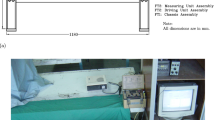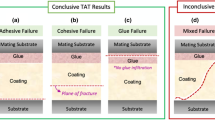Abstract
The mode of failure and failure probability of a brittle coating on a compliant substrate subjected to a static load through a spherical indenter is investigated experimentally and theoretically. We extend our recent study (2003, J Mat Sci 38:1589) of surface crack initiation in a monolithic solid to the layered system, and account for the multi axial stress state of the indentation in the failure probability analysis. Two modes of failure, a Hertzian cone crack initiating from the contacting surface and a half-penny-shaped crack initiating from the interface, are investigated and the probability of failure initiation for both surfaces are theoretically predicted and compared with experimental data.
The effect of interface debonding on failure phenomena is investigated. For a given load the failure probability for debonded specimens is significantly higher than that of well-bonded samples. For the debonded case the theoretical failure probability curve falls within the 90% confidence interval of the experimental data, while the experimental values for the completely bonded case show somewhat lower failure probabilities than that predicted. This may be attributed to the possible bridging effect by the adhesive on interfacial surface defects in the ceramic that is not accounted for in our model.



















Similar content being viewed by others
References
Lawn BR, Deng Y, Miranda P, Pajares A, Chai H, Kim DK (2002) J Mater Res 17(12):3019
Chai H, Lawn BR (1999) J Mater Res 14(9):3805
Miranda P, Pajares A, Guiberteau F, Cumbrera FL, Lawn BR (2001) Acta Mater 49(18):3719
Tsai YL, Petsche PE, Anusavice KJ, Yang MC (1998) Int J Prosthodont 11(1):27
Wang R, Katsube N, Seghi RR, Rokhlin SI (2003) J Mater Sci 38:1589
Frank FC, Lawn BR (1967) In: Proceedings of the Royal Society of London A299(1458) p 291
Mouginot R, Maugis D (1985) J Mater Sci 20:4354
Wiederhorn SM (1974) et al ibid. 57:336
Wiederhorn SM, et al (1974) In: Bradt RC (ed) Fracture mechanics of ceramics, vol 2, Plenum, p 829
Shetty DK, Rosenfield AR, McGuire P, Bansal GK, Duckworth WH (1980) Ceram Bull 59(12):1193
Dodson M (1994) In: Weibull analysis. ASQ Quality Press, Milwaukee, Wisconsin. p 66
Johnson KL (1996) In: Contact mechanics. Cambridge University Press, Cambridge UK
Barovich D, Kingsley SC, Ku TC (1964) Int J Eng Sci 2:253
Fisher-Cripps AC (1997) J Mater Sci 32:1277
Weibull W (1939) In: A statistical theory of the strength of materials. Handlingar Nr 151. Ingeniors Vetenskaps Akademins, Stockholm
Batdorf SB, Crose JG (1974) J Appl Mech 41:459
Batdorf SB, Heinisch ML Jr (1978) J Am Ceram Soc 61(7–8):355
Chao LY, Shetty DK (1991) J Am Ceram Soc 74(2):333
Rosenstiel S, Gupta P, Van Der Sluys R, Zimmerman M (1993) Dent Mater 9:274
Burke FJ, Fleming GJ, Nathanson D, Marquis PM (2002) J Adhes Dent Spring 4(1):7
Acknowledgments
This research was supported by the Ohio State University Interdisciplinary Biomaterials Seed Grants and by NIHDCR grant number R21 DE014719-02.
Author information
Authors and Affiliations
Corresponding author
Appendices
Appendix
Discussion of statistical parameters for indentation contact problem
In an infinitesimal concentric ring bounded by radii r i and r i + δr with constant radial stress σ rr, the failure probability is given [5, 14] as follows:
It is implicitly assumed in Eq. 19 that only the maximum principal stress component (must be tensile) affects the failure probability. The influence of the other principal stress components on the failure probability is neglected. For example, in Fig. 20, a crack is oriented in the direction of the principal stress components σ 1 (σ 1 ≥ σ 2). In the case A, the σ 2 is compressive and in the case B is tensile. Since Eq. 19 does not account for the differences in stress states between A and B (no dependence on σ 2), the predicted failure distributions of the two cases are identical. Obviously this is not the case. The crack in case A cannot propagate due to compressive stress applied normal to the crack surface, while the crack in case B may propagate if the magnitude of the applied tensile stress σ2 satisfies the fracture criterion.
Illustration of the two different stress states for a crack. In case A crack is under compression and does not propagate, in case B it propagates while Eq. 19 predicts identical results for both cases
In order to overcome this limitation and more accurately reflect the multi-axial stress states, we will use the method proposed by Batdorf et al. [16, 17] (Eq. 6). Equation 6 accounts for the stress components other than the first principal stress in calculation of the failure probability through the solid angle Ω. Within the framework of the probability model (Eq. 6), the probability of crack propagation is proportional to Ω/2π and is measured by the probability of its normal n falling within the solid angle Ω. For example in Fig. 21, the failure will occur when the crack normal n is within the sector Ω, and the failure will not occur when n is outside of this sector. Therefore, the influence of σ 2 on crack propagation probability is accounted for by calculation [16, 17] of the solid angle Ω for a given stress state (the resulting Ω will depend on stress state, crack size and failure criterion selected). In particular, if a crack in case Fig. 20B satisfies the failure criterion (σ 2 = σ c), then Ω is equal to 2π and it will propagate, and for the same crack in Fig. 20A, Ω is less than 2π and it will not propagate.
To account for the multi-axial stress state, we have derived from Eq. 6 the modified distribution in the form:
where \( \ifmmode\expandafter\bar\else\expandafter\=\fi{k} \) depends on stress state and is given by
Here σ tt is the hoop stress and \( \Omega {\left( {\tfrac{{\sigma _{{tt}} }} {{\sigma _{{rr}} }}{\hbox{,}}\tfrac{{\sigma _{c} }} {{\sigma _{{rr}} }}} \right)} \) is determined from the actual surface stress state.
Equation 20 will reduce to Eq. 19 for a uniaxial tensile stress state.
Rights and permissions
About this article
Cite this article
Wang, R., Katsube, N., Seghi, R.R. et al. Statistical failure analysis of brittle coatings by spherical indentation: theory and experiment. J Mater Sci 41, 5441–5454 (2006). https://doi.org/10.1007/s10853-006-0322-2
Received:
Accepted:
Published:
Issue Date:
DOI: https://doi.org/10.1007/s10853-006-0322-2






